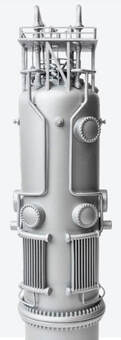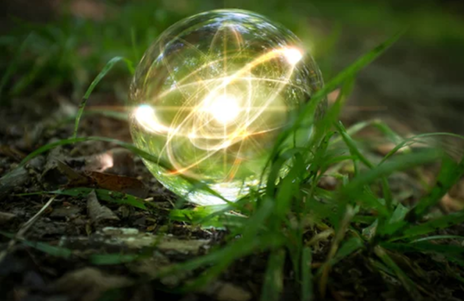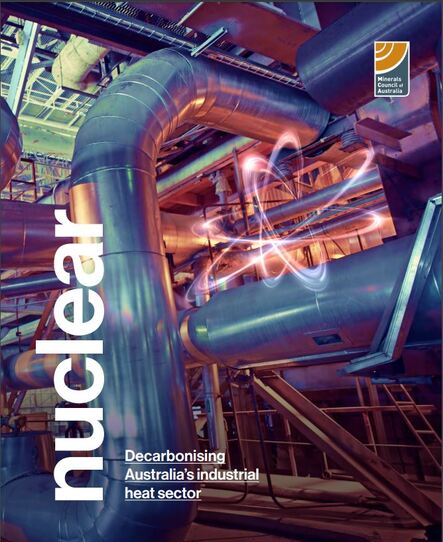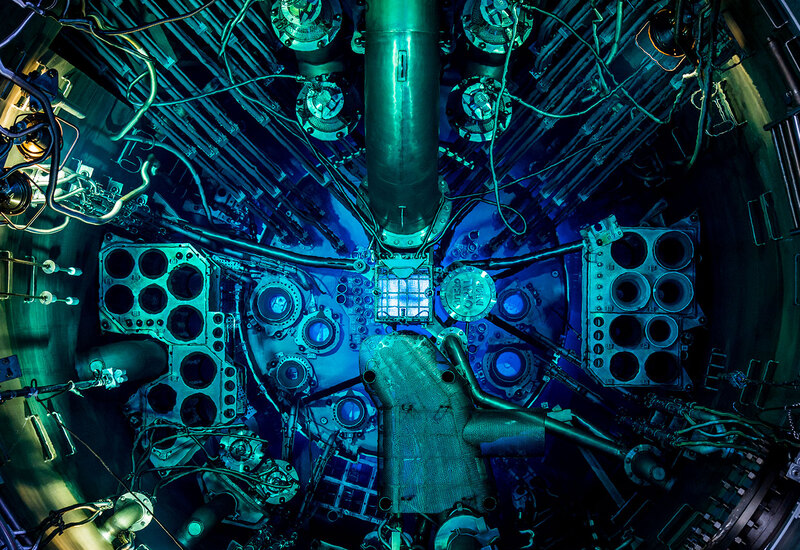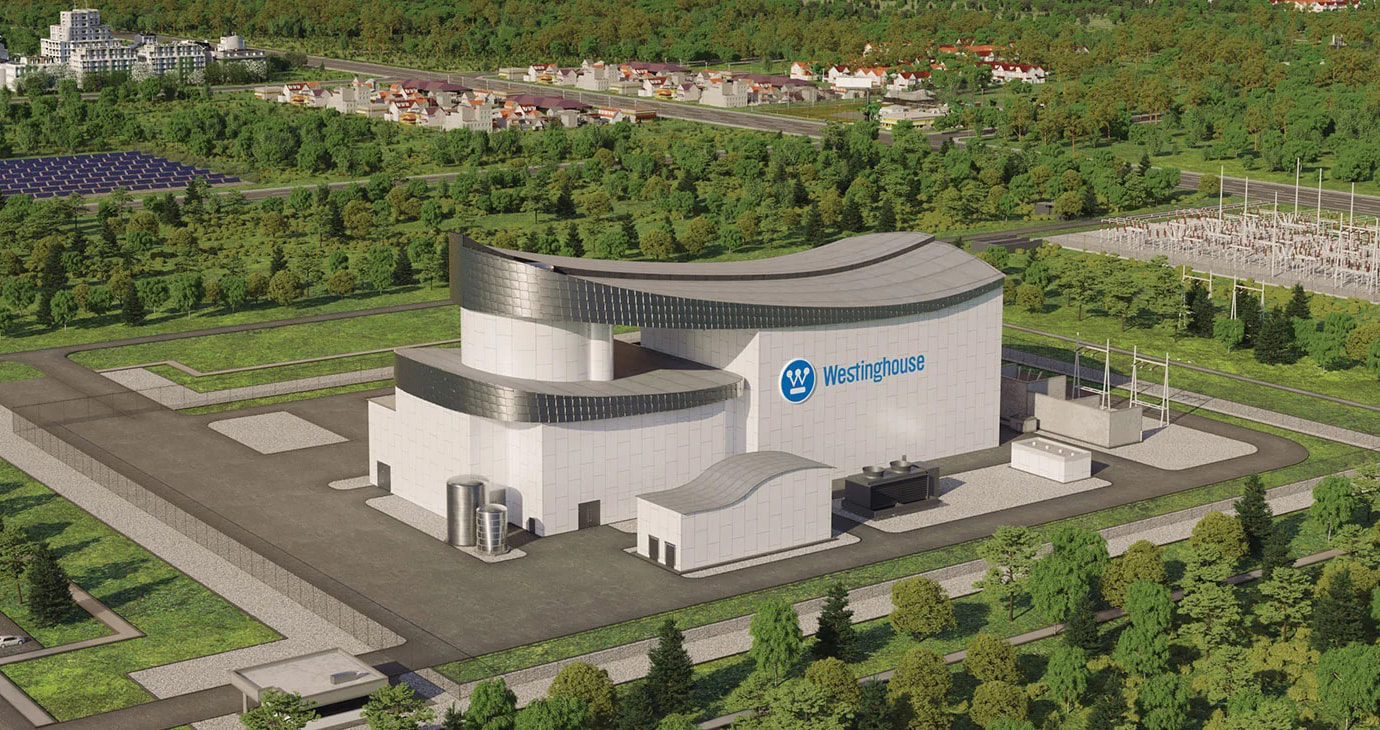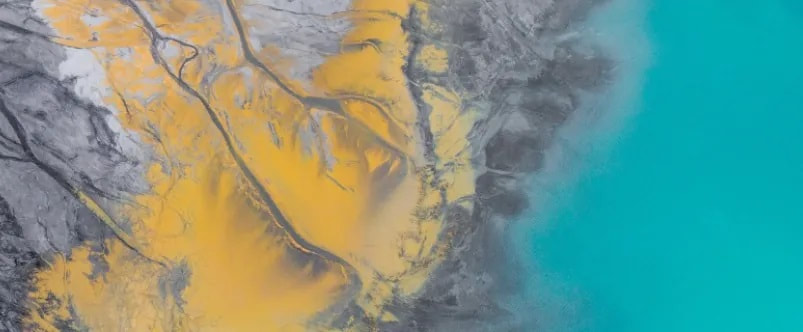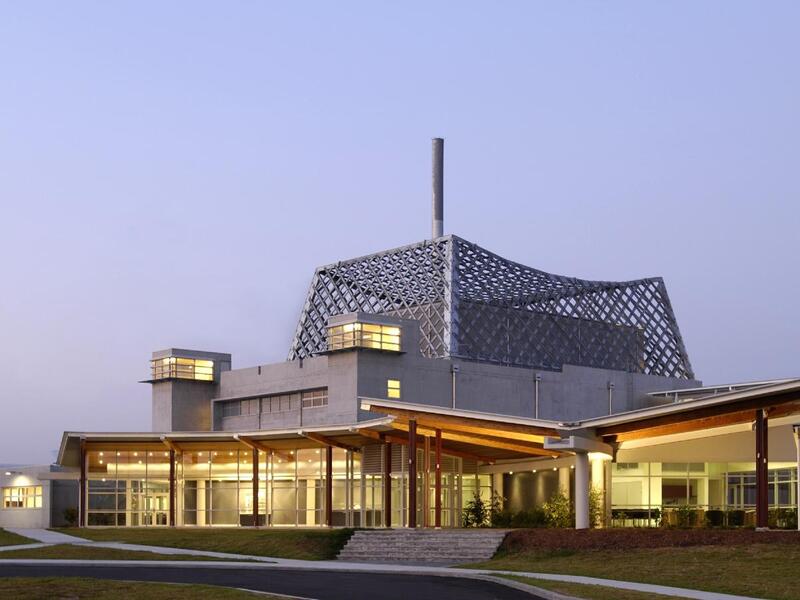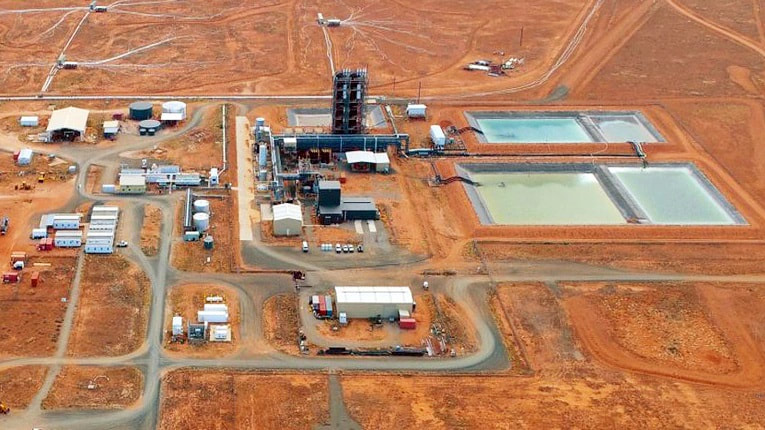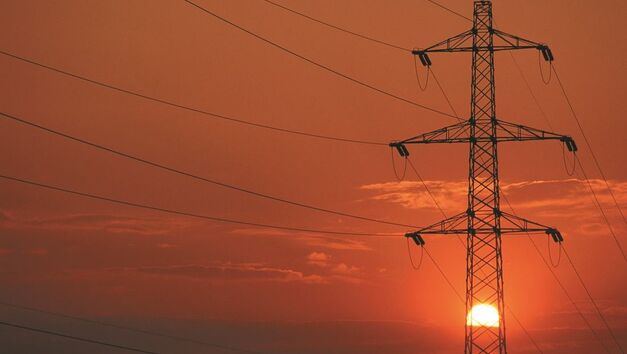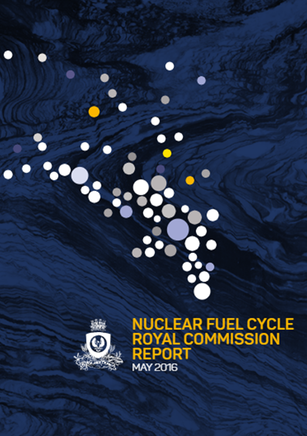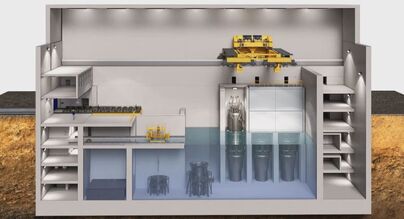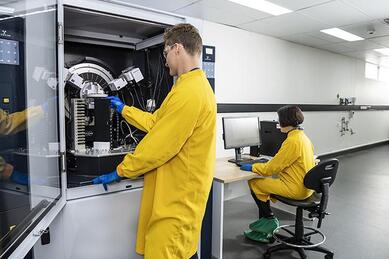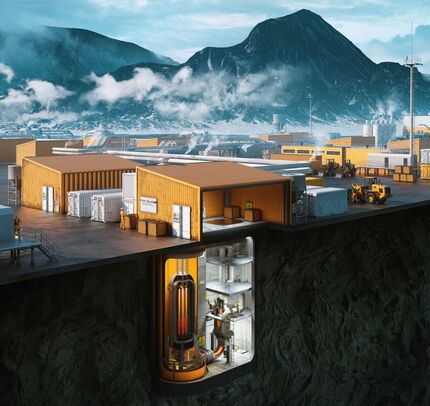Nuclear energy is a low-carbon energy source, capable of producing large amounts of electricity with zero-emissions. It is a proven technology that is used around the world as a safe, affordable and reliable baseload energy source.
|
What is Nuclear Energy?
Nuclear energy involves splitting atoms in a reactor to generate heat and releasing significant amounts of energy. This process is known as ‘nuclear fission’ and represents approximately 10% of how the world’s electricity is produced. Like automobiles, the nuclear reactors of today are vastly superior to their predecessors from the 1950s. Today’s reactors are smaller and easier to build. They are also far more technologically advanced; some designs even use spent nuclear waste as fuel. For decades, micro-reactors have silently powered fleets of submarines and aircraft carriers. Inspired by these designs and the advantages of factory-based automated manufacturing, we are now on the precipice of a revolution in the commercial nuclear sector brought on by Small Modular Reactors (SMRs). The energy that is produced from SMRs is safe, scalable, and importantly for Australia, could replace some of the baseload power lost through rolling closures of old and defunct power stations. A golf-ball sized amount of nuclear material can provide a lifetime’s amount of energy for one person [i]. |
SACOME's Position on Nuclear Energy
|
SACOME’s longstanding position is that all low-emission technologies should be considered as part of the future energy mix to ensure both rapid decarbonisation and energy reliability.
SACOME’s member companies continue to express clear public statements of support for the Paris Agreement and have made significant commitments and progress to reduce emissions well ahead of 2050 targets. However, SACOME acknowledges that meeting Net Zero at the speed and scale required cannot be achieved with renewables alone, despite South Australia’s successful uptake of wind and solar power. At the end of 2023, SACOME partnered with the Minerals Council of Australia (MCA) to host a nuclear energy thought leadership forum. A panel of national and international nuclear energy experts discussed the potential benefits and opportunities of nuclear for South Australia. The forum was an opportunity to sort fact from fiction in relation to time, cost, waste, safety and siting. The panel of experts consisted of: Helen Cook, Lenka Kollar, Dr Geordie Graetz, Assoc. Prof. Tony Hooker and Brian Reilly and was facilitated by Rikki Lambert. In December 2022, SACOME provided a submission to the Environment and Communications Legislation Committee in support of Senator Matt Canavan’s introduction of the Environment and Other Legislation Amendment (Removing Nuclear Prohibitions) Bill 2022. SACOME’s submission is consistent with SACOME’s Energy Policy and longstanding position that all low-emission technologies should be considered as part of Australia’s future energy mix. SACOME also welcomed Premier Peter Malinauskas’ comments on the role nuclear energy can play in decarbonisation. |
|
|
What role can nuclear energy play in reaching Net Zero?
Decarbonisation at the scale required to address climate change cannot be achieved with renewables alone. All low-emission technologies, including nuclear, should be considered as part of the future energy mix. Nuclear energy provides the opportunity to partner with renewables as a reliable source of energy with zero carbon emissions. It would provide a baseload energy stream when the sun doesn’t shine or the wind doesn’t blow and would help Australia meet its Net Zero commitments under the Paris Agreement. Nuclear energy can provide 24/7 baseload power to help stabilise the electricity grid. |
Due to technological advancements and the accelerated global commercialisation of SMRs, nuclear energy offers an affordable, reliable, zero-emissions energy solution for Australia.
Community Support for Nuclear
57% of South Australians support having a conversation about nuclear energy.
A Lowy Institute poll, released in June 2022, reported a majority – 52% of Australians - favoured overturning the ban on nuclear power, up from 47% in the previous year.
A poll commissioned by the Institute of Public Affairs in June 2022 identified that a majority of Australians backed nuclear power, with 53% agreeing that Australia should build nuclear power plants to supply electricity and reduce carbon emissions.
In July 2022, SACOME commissioned a community sentiment survey of 600 South Australians to evaluate the views of the public and see if they were open to a balanced conversation on nuclear energy. The survey found that 57% of South Australians support having an “informed and balanced conversation about having a nuclear energy industry in South Australia”. Of those surveyed, 58% support progressing the necessary political conversations and legislative frameworks to enable future nuclear energy use in South Australia. The results also found that more than six in 10 adults (63%) agree that given recent cost and reliability issues of the Australian electricity market, all energy sources, including nuclear, should be on the table for consideration.
A recent poll by The Advertiser found 85% of readers support a nuclear energy future for SA, from 891 votes. In a similar poll in December 2022, 85% of readers agreed with Premier Peter Malinauskas on his comments on being “open minded” on nuclear power from 1661 votes.
Correspondingly, results of a Australian Financial Review snap poll taken in July 2023, showed nearly two-thirds of readers surveyed want Australia to consider small modular nuclear reactors as part of the solution for abandoning fossil fuels.
A poll commissioned by the Institute of Public Affairs in June 2022 identified that a majority of Australians backed nuclear power, with 53% agreeing that Australia should build nuclear power plants to supply electricity and reduce carbon emissions.
In July 2022, SACOME commissioned a community sentiment survey of 600 South Australians to evaluate the views of the public and see if they were open to a balanced conversation on nuclear energy. The survey found that 57% of South Australians support having an “informed and balanced conversation about having a nuclear energy industry in South Australia”. Of those surveyed, 58% support progressing the necessary political conversations and legislative frameworks to enable future nuclear energy use in South Australia. The results also found that more than six in 10 adults (63%) agree that given recent cost and reliability issues of the Australian electricity market, all energy sources, including nuclear, should be on the table for consideration.
A recent poll by The Advertiser found 85% of readers support a nuclear energy future for SA, from 891 votes. In a similar poll in December 2022, 85% of readers agreed with Premier Peter Malinauskas on his comments on being “open minded” on nuclear power from 1661 votes.
Correspondingly, results of a Australian Financial Review snap poll taken in July 2023, showed nearly two-thirds of readers surveyed want Australia to consider small modular nuclear reactors as part of the solution for abandoning fossil fuels.
Nuclear Energy for Industrial HeatIn November 2024, The Minerals Council of Australia (MCA) released its Nuclear: Decarbonising Australia's Industrial Heat Sector report, outlining the difficulty the nation's industrial base faces in reducing emissions, and the obvious solution.
The report pin points the critical need to provide Australia's manufacturers, industrial companies and miners with the ability to properly decarbonise its heating and refining operations; where electrification is not possible. Australia has, in abundance, what the world needs to meet its climate ambition; the critical minerals such as copper, cobalt, lithium and nickel that form the components of electric vehicles, solar panels and wind turbines. But to secure a vital place in the global supply chain, Australia needs the investment and capability to not only extract such rare earths and minerals, but to process them in a cost-effective and reliable way, rather than have China do it for us, only for us to buy back the finished technology. Nuclear energy is that enabler. |
Nuclear Energy around the World
Nuclear energy is widely used around the world, providing about 10% of the world’s electricity needs[v].
Currently, there are approximately 440 reactors operating in 31 countries;[vi] with 56 units under construction, 96 at the planning stage and another 325 proposed.
All five permanent members of the United Nations Security Council – the United States, France, the United Kingdom, Russia, and China – are planning the expansion of their civil nuclear programmes.
In South-East Asia Vietnam, Thailand, Laos, Cambodia, Singapore, Indonesia, Philippines, and Sri Lanka are either considering nuclear power or planning the acquisition of nuclear power[xvi]. Singapore has recently announced that nuclear energy could supply 20% of Singapore’s electricity by 2050.
More than 50 other countries[xvii] who do not currently use nuclear power are considering the introduction of nuclear power; 23 are in a pre-decision phase and 27 are actively pursuing the introduction of nuclear power.
All five permanent members of the United Nations Security Council – the United States, France, the United Kingdom, Russia, and China – are planning the expansion of their civil nuclear programmes.
- The United Kingdom[vii] is building eight more nuclear reactors, tripling its current production, and a suite of SMRs.
- Following the completion of a reactor in 2016, two more reactors are scheduled to come online in the United States[viii] before 2023.
- In France, 70% of their electricity comes from nuclear power and it remains the world’s largest net electricity exporter; nonetheless President Macron has announced construction of up to 14 new reactors[ix] and a fleet of SMRs.[x]
- Russia[xi] plans for 11 more reactors by 2030, and aims to have up to 50%[xii] of their energy derive from nuclear by 2050.
- To lower its emissions, China[xiii] is planning to significantly increase its nuclear power output to 150GW by 2030, almost three times their current capacity and surpassing the capacity of two largest producers of nuclear power, the United States and France, combined.
In South-East Asia Vietnam, Thailand, Laos, Cambodia, Singapore, Indonesia, Philippines, and Sri Lanka are either considering nuclear power or planning the acquisition of nuclear power[xvi]. Singapore has recently announced that nuclear energy could supply 20% of Singapore’s electricity by 2050.
More than 50 other countries[xvii] who do not currently use nuclear power are considering the introduction of nuclear power; 23 are in a pre-decision phase and 27 are actively pursuing the introduction of nuclear power.
Nuclear Energy in Australia
Australia remains the only G20 nation with a legislative prohibition on the development of nuclear energy.
The prohibition came into effect in 1998 at a time when energy was affordable, abundant and the need to decarbonise was less understood.
The production of nuclear energy is currently prohibited under two Acts of Parliament: The Federal Australian Radiation Protection and Nuclear Safety Act 1998 (ARPANS Act) and the Environment Protection and Biodiversity Conservation Act 1999 (EPBC Act).
A single amendment to the EPBC Act – the removal of four words ‘a nuclear power plant’ in Section 140A(1)(b) - would allow nuclear industries to be considered for development in Australia.
If the EPBC Act was amended, as per above, nuclear projects would still need to meet Australia’s stringent environmental regulations and safety requirements. It would, however, incentivise industry to take the lead and allow global entrepreneurs and innovators to develop and commercialise nuclear energy designs and technology in Australia, with the prospect of possible deployment in Australia’s energy system in the future.
The prohibition in the ARPANS Act applies only to Commonwealth entities and therefore is not an immediate barrier for the consideration of nuclear power by either a State Government entity or a private sector developer.
Concerted, bipartisan efforts from all sides of politics is needed to advance public policy on nuclear energy and amend the prohibition to enable nuclear energy in Australia in the future.
The production of nuclear energy is currently prohibited under two Acts of Parliament: The Federal Australian Radiation Protection and Nuclear Safety Act 1998 (ARPANS Act) and the Environment Protection and Biodiversity Conservation Act 1999 (EPBC Act).
A single amendment to the EPBC Act – the removal of four words ‘a nuclear power plant’ in Section 140A(1)(b) - would allow nuclear industries to be considered for development in Australia.
If the EPBC Act was amended, as per above, nuclear projects would still need to meet Australia’s stringent environmental regulations and safety requirements. It would, however, incentivise industry to take the lead and allow global entrepreneurs and innovators to develop and commercialise nuclear energy designs and technology in Australia, with the prospect of possible deployment in Australia’s energy system in the future.
The prohibition in the ARPANS Act applies only to Commonwealth entities and therefore is not an immediate barrier for the consideration of nuclear power by either a State Government entity or a private sector developer.
Concerted, bipartisan efforts from all sides of politics is needed to advance public policy on nuclear energy and amend the prohibition to enable nuclear energy in Australia in the future.
Opportunity for South Australia
|
A local nuclear industry presents enormous untapped environmental and economic opportunities for South Australia.
In many ways, South Australia is already a 'nuclear' jurisdiction. With the signing of the AUKUS agreement in 2023, Australia’s next generation nuclear-powered submarines will be built in South Australia. It is anticipated that four submarines, each equipped with a Small Modular Reactor, will be in dry dock at any one time. South Australia is also a world-class uranium province, hosting 25% of the world’s uranium resources and 80% of Australia’s uranium. BHP’s Olympic Dam is the world’s largest uranium deposit, containing more than 2 million tonnes of uranium oxide. All of the uranium oxide concentrate produced in South Australia is currently exported exclusively for the generation of electricity in civil nuclear reactors in countries around the world. In 2020, the total sales value of uranium produced in South Australia was $521 million[xviii]. South Australia has a well-developed regulatory framework governing the uranium supply chain and is home to the Australian Radioactive Waste Agency. |
While South Australia is at the forefront of the renewable transition, South Australia still has the highest electricity prices in the nation [xix]. The State still requires baseload energy for when renewable energy is not available and until adequate storage technology has been developed and adopted.
Modern reactors coupled with South Australia’s abundant gas and renewable energy would facilitate rapid decarbonisation while ensuring South Australian industrial and household users have access to affordable, reliable and low-carbon energy 24/7. |
South Australia's Nuclear Fuel Cycle Royal Commission
|
In 2015, a Royal Commission was conducted into South Australia’s future role in the Nuclear Fuel Cycle.
The Commission, led by former South Australian Governor Kevin Scarce, delivered its final report in May 2016 and recommended that the South Australian Government “pursue removal at the federal level of existing prohibitions on nuclear power generation to allow it to contribute to a low-carbon electricity system, if required.” While the Commission found that it would not be commercially viable to develop a nuclear power plant in South Australia beyond 2030 “under current market rules”, it went on to say: “There will be in coming decades a need to significantly reduce carbon emissions and as a result to decarbonise Australia’s electricity sector.” The report also said: “Nuclear power, as a low-carbon energy source comparable with other renewable technologies, may be required as part of a lower-carbon electricity system. While the development of other low-carbon technologies will influence whether nuclear power would be required to meet Australia’s future energy needs, it would not be able to play a role unless action is taken now to plan for its potential implementation.” |
|
How does a Small Modular Reactor work?
Controlled nuclear chain reaction -> creates the steam -> that powers the turbine -> and generates electricity. An SMR’s power capacity can range from approximately 10 MW(e) to 300 MW(e) per unit, compared to the typical 1000 MW of a traditional nuclear power station. The smaller reactor core gives distinct advantages in construction, dramatically decreasing costs and geographical footprint. SMRs use about 1/1000th as much land as other clean energy sources such as solar or wind farms. SMRs are ‘modular’, making it possible for systems and components to be factory-assembled and transported as a unit to a location for easy installation. SMRs can be scaled up to meet a region’s specific energy demands and can be deployed for various uses including supplying electricity direct to the grid, powering heavy industry or off grid, for regional communities. They are highly suited to Australia as they can be installed on brownfield sites, scaled up or down and can use existing infrastructure to send power to the grid to support renewable energy production. The refinement and commercialisation of SMRs is progressing rapidly. Companies such as NuScale, Rolls-Royce, and TerraPower are advancing designs for SMRs, with NuScale having recently received regulatory approval from US authorities. 4 SMRs could power 1.2 million average Australian households (based on an average household electricity consumption of <8000kWh per year. Each SMR = 300MW). |
|
|
How safe are Small Modular Reactors?
SMRs are designed with passive or inherent safety features. This means operator intervention or external power supply are not needed to shut down the reactor and maintain cooling to remove the core’s residual heat in the event that power is lost at the plant [ii]. SMRs use only a small amount of fuel and refuel approximately every two years. They also produce less spent reactor fuel which can be re-used or stored securely in dry concrete casks until radiation levels have reduced by natural decay and then stored in deep geological depositories. Nuclear energy is the only large-scale energy producing technology that takes full responsibility for its waste. |
Nuclear energy has been operating safely for more than 60 years and is one of the most reliable sources of energy generation available.
|
How much does a Small Modular Reactor cost? The cost of an SMR is contingent on the technology selected, including its size, generation and purpose. The cost of the electricity produced will also vary between products and projects. It is anticipated that capital expenditure for a 300MW SMR will be in the range of $1.5 billion to $3 billion [iii] or a larger modular reactor would be in the range of $5 billion dollars (based on the cost of a NuScale 12 module 884 MWe SMR which produce 7.3 TWh of energy). This cost is equivalent to the construction of renewable infrastructure to achieve the same outcome. SMRs are expected to deliver electricity for between A$60-$110 per MWh, likely making SMRs the cheapest zero-emission baseload power source [iv]. |
[i] The Minerals Council of Australia - The Case for Nuclear.
[ii] https://www.ansto.gov.au/news/what-are-small-modular-reactors-and-what-makes-them-different
[iii] https://www.afr.com/companies/energy/the-rolls-royce-option-for-australian-nuclear-power-20190822-p52jpn
[iv] The Minerals Council of Australia - The Case for Nuclear
[v] https://world-nuclear.org/information-library/current-and-future-generation/nuclear-power-in-the-world-today.aspx
[vi] https://www.theaustralian.com.au/business/mining-energy/australia-at-centre-of-uranium-boom-as-nuclear-power-helps-green-push/news-story/2d397bef68bd6123ee620b7b0e2907bc
[vii] https://www.abc.net.au/news/2022-04-08/uk-looks-to-nuclear-power-to-cut-russian-energy-dependence/100977952
[viii] https://www.eia.gov/energyexplained/nuclear/us-nuclear-industry.php#:~:text=The%20two%20new%20reactors%20that,to%20five%20years%20to%20complete.
[ix] https://www.theguardian.com/world/2022/feb/10/france-to-build-up-to-14-new-nuclear-reactors-by-2050-says-macron
[x] https://onu-vienne.delegfrance.org/Nuclear-power-and-SMR-are-central-to-the-France-2030-investment-plan
[xi] https://world-nuclear.org/information-library/country-profiles/countries-o-s/russia-nuclear-power.aspx
[xii] https://www.climatescorecard.org/2021/09/russia-plans-to-have-45-50-of-its-electricity-supply-derive-from-nuclear-power-by-2050/
[xiii]https://asia.nikkei.com/Business/Energy/China-greenlights-6-new-nuclear-reactors-in-shift-away-from-coal#:~:text=China%20had%2053%20nuclear%20power,surpass%20the%20U.S.%20and%20France
[xiv] https://smractionplan.ca/
[xv] https://cib-bic.ca/en/medias/articles/cib-commits-970-million-towards-canadas-first-small-modular-reactor/
[xvi]https://www.youtube.com/watch?v=1RF0OeLpXD0
[xvii] https://www.youtube.com/watch?v=1RF0OeLpXD0
[xviii] https://www.sapc.sa.gov.au/__data/assets/pdf_file/0007/847348/Renewable-Energy-Competitiveness-Final-Report-Website-Version.pdf
[xix] https://www.sapc.sa.gov.au/__data/assets/pdf_file/0007/847348/Renewable-Energy-Competitiveness-Final-Report-Website-Version.pdf
[ii] https://www.ansto.gov.au/news/what-are-small-modular-reactors-and-what-makes-them-different
[iii] https://www.afr.com/companies/energy/the-rolls-royce-option-for-australian-nuclear-power-20190822-p52jpn
[iv] The Minerals Council of Australia - The Case for Nuclear
[v] https://world-nuclear.org/information-library/current-and-future-generation/nuclear-power-in-the-world-today.aspx
[vi] https://www.theaustralian.com.au/business/mining-energy/australia-at-centre-of-uranium-boom-as-nuclear-power-helps-green-push/news-story/2d397bef68bd6123ee620b7b0e2907bc
[vii] https://www.abc.net.au/news/2022-04-08/uk-looks-to-nuclear-power-to-cut-russian-energy-dependence/100977952
[viii] https://www.eia.gov/energyexplained/nuclear/us-nuclear-industry.php#:~:text=The%20two%20new%20reactors%20that,to%20five%20years%20to%20complete.
[ix] https://www.theguardian.com/world/2022/feb/10/france-to-build-up-to-14-new-nuclear-reactors-by-2050-says-macron
[x] https://onu-vienne.delegfrance.org/Nuclear-power-and-SMR-are-central-to-the-France-2030-investment-plan
[xi] https://world-nuclear.org/information-library/country-profiles/countries-o-s/russia-nuclear-power.aspx
[xii] https://www.climatescorecard.org/2021/09/russia-plans-to-have-45-50-of-its-electricity-supply-derive-from-nuclear-power-by-2050/
[xiii]https://asia.nikkei.com/Business/Energy/China-greenlights-6-new-nuclear-reactors-in-shift-away-from-coal#:~:text=China%20had%2053%20nuclear%20power,surpass%20the%20U.S.%20and%20France
[xiv] https://smractionplan.ca/
[xv] https://cib-bic.ca/en/medias/articles/cib-commits-970-million-towards-canadas-first-small-modular-reactor/
[xvi]https://www.youtube.com/watch?v=1RF0OeLpXD0
[xvii] https://www.youtube.com/watch?v=1RF0OeLpXD0
[xviii] https://www.sapc.sa.gov.au/__data/assets/pdf_file/0007/847348/Renewable-Energy-Competitiveness-Final-Report-Website-Version.pdf
[xix] https://www.sapc.sa.gov.au/__data/assets/pdf_file/0007/847348/Renewable-Energy-Competitiveness-Final-Report-Website-Version.pdf

